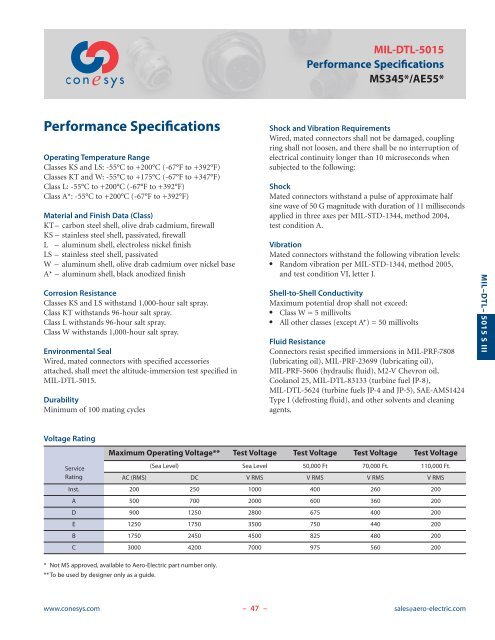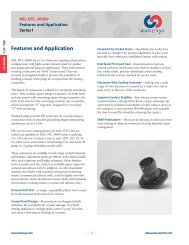Conesys - Aero-Electric Connector, Inc.
Conesys - Aero-Electric Connector, Inc.
Conesys - Aero-Electric Connector, Inc.
Create successful ePaper yourself
Turn your PDF publications into a flip-book with our unique Google optimized e-Paper software.
Performance Specifications<br />
Operating Temperature Range<br />
Classes KS and LS: -55°C to +200°C (-67°F to +392°F)<br />
Classes KT and W: -55°C to +175°C (-67°F to +347°F)<br />
Class L: -55°C to +200°C (-67°F to +392°F)<br />
Class A*: -55°C to +200°C (-67°F to +392°F)<br />
Material and Finish Data (Class)<br />
KT– carbon steel shell, olive drab cadmium, firewall<br />
KS – stainless steel shell, passivated, firewall<br />
L – aluminum shell, electroless nickel finish<br />
LS – stainless steel shell, passivated<br />
W–aluminum shell, olive drab cadmium over nickel base<br />
A* – aluminum shell, black anodized finish<br />
Corrosion Resistance<br />
Classes KS and LS withstand 1,000-hour salt spray.<br />
Class KT withstands 96-hour salt spray.<br />
Class L withstands 96-hour salt spray.<br />
Class W withstands 1,000-hour salt spray.<br />
Environmental Seal<br />
Wired, mated connectors with specified accessories<br />
attached, shall meet the altitude-immersion test specified in<br />
MIL-DTL-5015.<br />
Durability<br />
Minimum of 100 mating cycles<br />
Voltage Rating<br />
Service<br />
Rating<br />
* Not MS approved, available to <strong>Aero</strong>-<strong>Electric</strong> part number only.<br />
**To be used by designer only as a guide.<br />
MIL-DTL-5015<br />
Performance Specifications<br />
MS345*/AE55*<br />
Shock and Vibration Requirements<br />
Wired, mated connectors shall not be damaged, coupling<br />
ring shall not loosen, and there shall be no interruption of<br />
electrical continuity longer than 10 microseconds when<br />
subjected to the following:<br />
Shock<br />
Mated connectors withstand a pulse of approximate half<br />
sine wave of 50 G magnitude with duration of 11 milliseconds<br />
applied in three axes per MIL-STD-1344, method 2004,<br />
test condition A.<br />
Vibration<br />
Mated connectors withstand the following vibration levels:<br />
● Random vibration per MIL-STD-1344, method 2005,<br />
and test condition VI, letter J.<br />
Shell-to-Shell Conductivity<br />
Maximum potential drop shall not exceed:<br />
● Class W = 5 millivolts<br />
● All other classes (except A*) = 50 millivolts<br />
Fluid Resistance<br />
<strong>Connector</strong>s resist specified immersions in MIL-PRF-7808<br />
(lubricating oil), MIL-PRF-23699 (lubricating oil),<br />
MIL-PRF-5606 (hydraulic fluid), M2-V Chevron oil,<br />
Coolanol 25, MIL-DTL-83133 (turbine fuel JP-8),<br />
MIL-DTL-5624 (turbine fuels JP-4 and JP-5), SAE-AMS1424<br />
Type I (defrosting fluid), and other solvents and cleaning<br />
agents.<br />
Maximum Operating Voltage** Test Voltage Test Voltage Test Voltage Test Voltage<br />
(Sea Level) Sea Level 50,000 Ft 70,000 Ft. 110,000 Ft.<br />
AC (RMS) DC V RMS V RMS V RMS V RMS<br />
Inst. 200 250 1000 400 260 200<br />
A 500 700 2000 600 360 200<br />
D 900 1250 2800 675 400 200<br />
E 1250 1750 3500 750 440 200<br />
B 1750 2450 4500 825 480 200<br />
C 3000 4200 7000 975 560 200<br />
www.conesys.com – 47 –<br />
sales@aero-electric.com<br />
MIL–DTL– 5015 S III



